THE STORY OF AN AFRICAN WILD DOG
The Making of a BBC Natural World
Click to download in pdf format: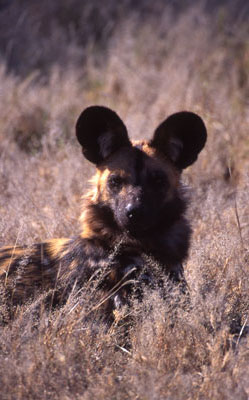
On the eastern fringes of the Okavango Delta in Botswana, spreads a patchwork of coarse yellow grass, variegated greens and browns of mopane forest, and grey dusty sand. There are dappled camelthorn woodlands, mantles of wild sage, islands of kigelia trees, and the beautiful twisted shapes of the loncocarpus capassa tree. It is a wilderness known as Santawani.
At home among the woodlands and floodplains is an African Wild Dog pack - fourteen adults and a bundle of boisterous pups. Part of the few viable remaining wild dog populations left in Africa, the Santawani pack is soon to become one of the most famous.
Kenyan-born wildlife cameraman, Mike Holding, first came to Santawani 20 years ago. For the last 5 years he and film producer Tania Jenkins (TJ) have been regular visitors, constantly renewing and cementing their ties with the resident wild dogs and local wild dog scientist, Dr. J.Weldon 'Tico' McNutt, who has been studying the packs in the area for the past 11 years.
While filming the Santawani pack for various international natural history programmes, Mike and TJ decided to embark on their own major documentary film project, to help to dispel the myths which surround the African Wild Dog and to bring to light some of the issues which threaten this critically endangered species. Mike recalls, "I sat down with Tico one evening and said "if you had to pick one dog you've known, who epitomised all of the challenges and difficulties that a wild dog might go through, who'd it be? And without hesitation he said 'Newky' and began to tell me the story of Newky's life. I remember we were sitting around the campfire and all the hairs on the back of my neck stood up, because it was just such a powerful story. This was the film story-line we were looking for. In this film we've tried to recreate the life of Newky and what he endured as faithfully as we possibly could. We've stuck with the tale of Newky's life, because it is such a fantastic story."
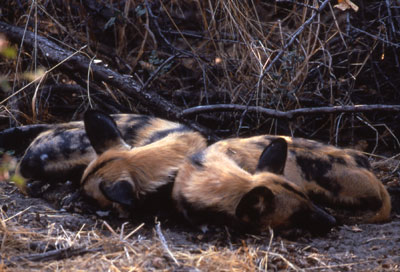
A 50-minute blue chip documentary, "A Wild Dog's Story" for the BBC's 'Natural World' series is the result. It is a re-creation of the true story of an African wild dog that manages to encapsulate all the joys, dangers and tragedies of being a wild dog in an increasingly perilous world. But more than narrating a simple story, Mike and TJ have set out to make a difference in this portrayal of Newky's life.
The day at film camp started when the dogs began to hunt - about 5 a.m, every morning. In winter this means facing chilling temperatures made all the more fearsome in an open vehicle, clutching onto the roll bar while crashing through the inky darkness peering at the fleeting canine shapes, here one minute and gone the next, absorbed by the blackened bush. When dogs go hunting, the camera crew pray that they will make their move after daybreak. In the dark it's virtually impossible to keep up with them as they slip into their rhythmic gait of a steady 20 kph.
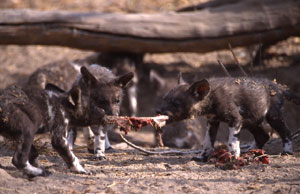
If successful, and the crew have managed to keep up with the flitting shapes in the engulfing darkness, and as night begins to melt into the soft roseate hues of dawn, the crew can settle in to their day. Standing next to Mike on the back of an open Range Rover as the dogs broke from their loping, long-legged trot to their spectacular hunting speed of nearly 60 kph was an unforgettable, adrenaline-charged experience. The film team's well-practised strategy in these vital seconds is to second-guess the dogs - and their prey - attempting to keep up with the luckless impala and to capture on film the magnificence of a wild dog in full gallop, as it runs its prey to the point of exhaustion, or skilfully tackles it to the ground. Dodging trees, low-flying branches, bone-breaking logs utterly hidden in long waving grass, and the most terrifying of all obstacles - cavernous, elephant-created holes that would comfortably swallow up the whole front end of an off-road vehicle - are all reasons why it is virtually impossible, without considerable luck, to catch this moment on film. As for the holes, I can tell you first hand that the hollow, reverberating thud of brutalised vehicle as it slams, full-tilt, into the sinister depths of a cavity the size of a small crater, is enough to send chills through the heart of the most hardened of bushwhackers. Mike and TJ have had more than their fair share of dangerous encounters with these car traps, and Mike has twice come away with a couple of broken ribs to show for the experience.
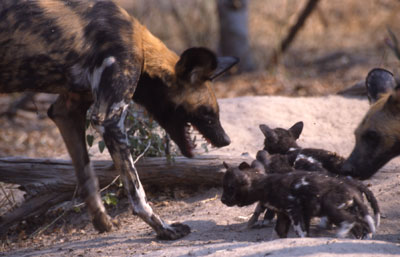
The wear and tear on people and vehicles in these kinds of conditions is an often-overlooked element amid the perceived glamour of wildlife filmmaking. By the end of their year in the bush, Mike and his crew were weary bush mechanics, fixing an average of 6 punctures a day, and repairing steering rods and suspension bars which regularly snapped in half from the sheer stress of high speed impact with obscured logs, tree stumps and holes. Mike retorts, "Let nobody tell you that being a wildlife cameraman is a glamorous job - you spend 5% of your time with wildlife, and 95% of your time stuck under a bloody broken vehicle!"
As the dogs are only active for about two hours morning and evening, and within that there is only 20 minutes of decent filming light, any time lost on vehicle breakdowns becomes intolerable. Ironically this also means that minutes spent trying to protect vehicles at the expense of falling behind the dogs, is also out of the question. Mike continues, "Wild dogs are coursers, they're like greyhounds, so they're out there trotting, or cantering miles and miles and miles and then running long distances at very high speeds on the hunt. If you lose them for 2 minutes you're not going to get any footage that morning - you have to keep up, and every second counts, so that's why the punishment on vehicles and equipment."
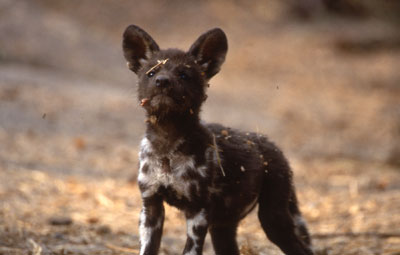
Under these often harrowing conditions, 'TJ's job back at base in Johannesburg was equally stressful. "Following wild dogs at high speed is incredibly dangerous, and just checking that the team were alive every day after each hunt was vital. There were times when radio communications would go down, and the camera crew could have been dead or injured somewhere in the middle of thousands of square kilometres. Where would you start to look for them, and who would look for them? They were miles from any kind of civilisation, so the responsibility on the producer for ensuring everyone was safe was huge."
From a filming point of view the off-road vehicles had to be equipped not only for brutal assaults through the bush, but also for speedy transition from hardy bush vehicle to sophisticated film-car. The result resembled something out of 'Mad Max', with steel bars and camera mounts liberally dispersed around the body of the car, and a sophisticated hydraulic platform mounted into the front passenger seat, which raised and lowered Mike's camera into position at the press of a button. " We've tried to film the movie from wild dog level, so that we're shoulder to shoulder with the dogs and we're seeing their world from their perspective. It's hard to emotionally involve an audience when you're always looking down on an animal. The nicest scenes in the film are going to be the many shots filmed from that low angle perspective."
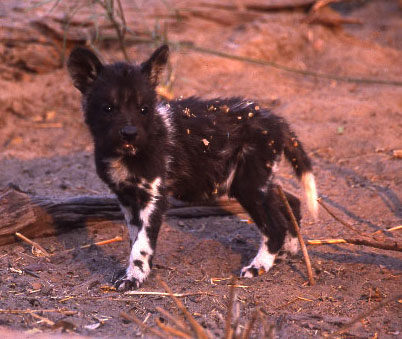
Among all the challenges that the team faced, do they feel they achieved what they set out to do? Mike believes they have. "I've probably set extremely high expectations for what I thought we could achieve with the film, and even if I'd shot everything on the shot-list I still wouldn't be satisfied, but I think it'll be a good film and it'll do justice to Newky's story, which is what we set out to accomplish. Beyond the film itself, if we don't all do something to preserve wild dogs, they'll have little time left on this planet. If we as humanity have made the decision that we need to share the planet with its other inhabitants, and if we've made that decision because we realise we've got something to learn from life on earth, then there can't be a better social animal from whom we could learn than from wild dogs. The more we can know about them, and discover from them about how to co-operate and behave in a supportive, altruistic way, the more the planet will benefit and the more humanity can grow in new ways."
TJ concludes, "If the film can touch one or two lives as the wild dogs have touched mine, then we've done enough. If one or two people can say 'hey, there's a different way of living, there's a different way of being', and be touched in their soul so that their soul wants to live differently, then we've done way more than make a 'Natural World' film."
